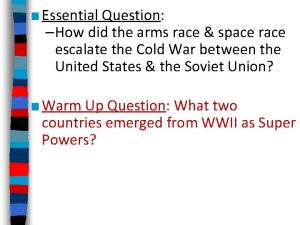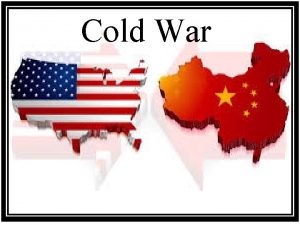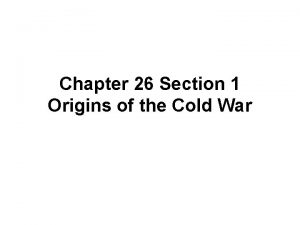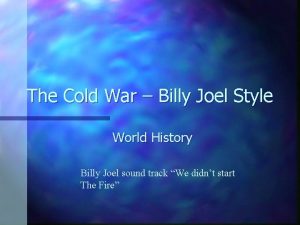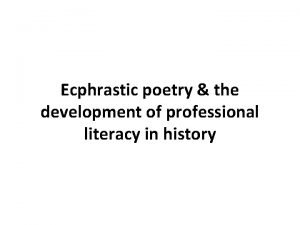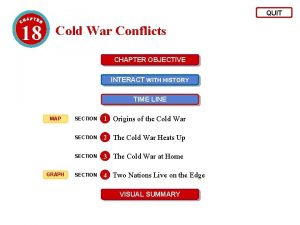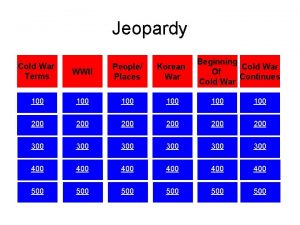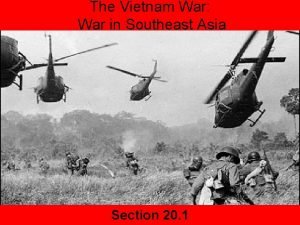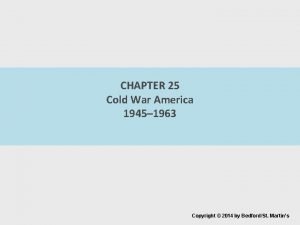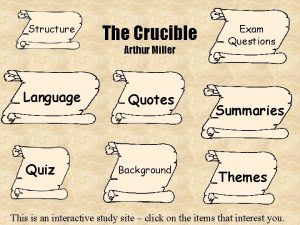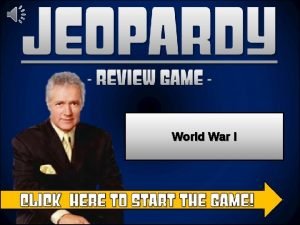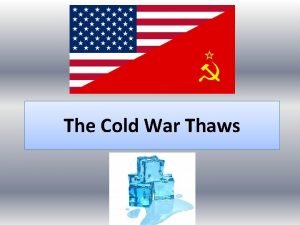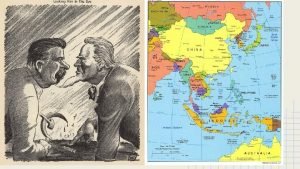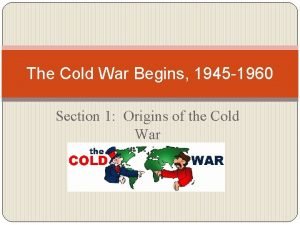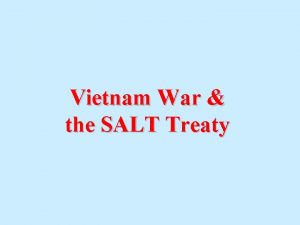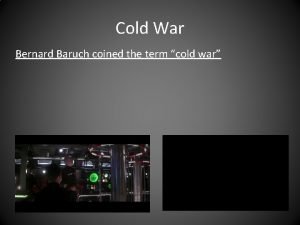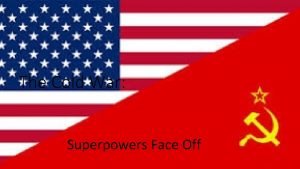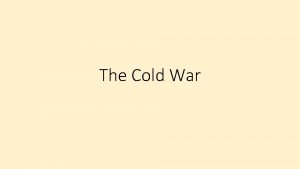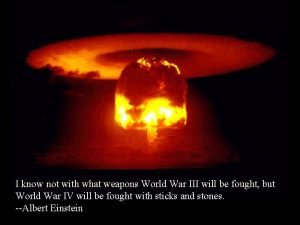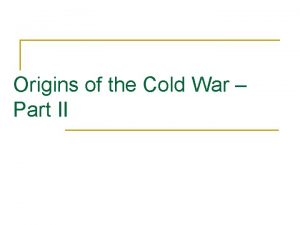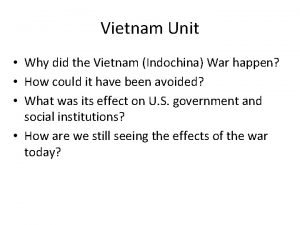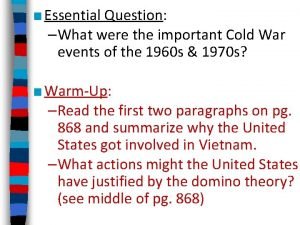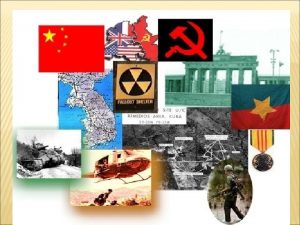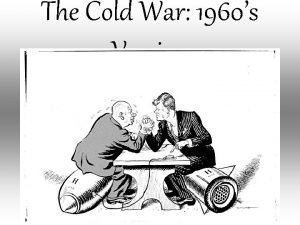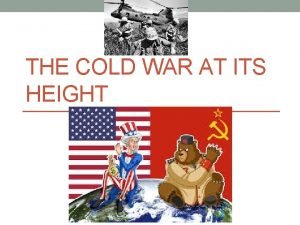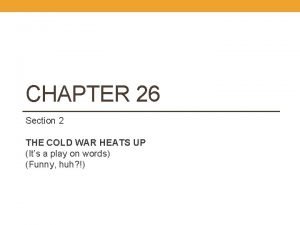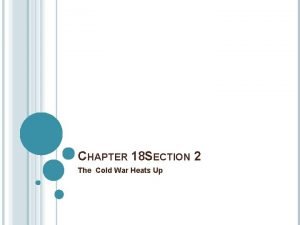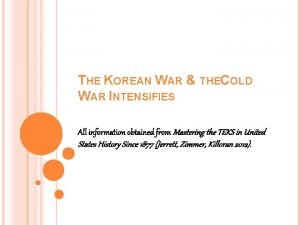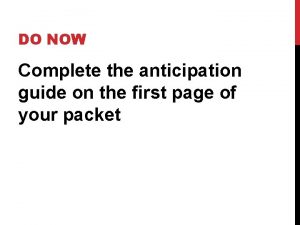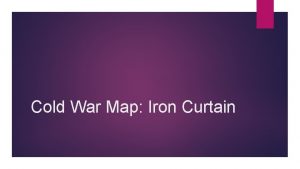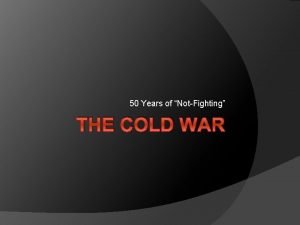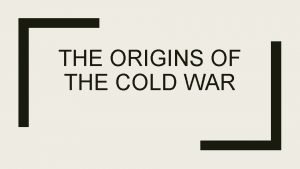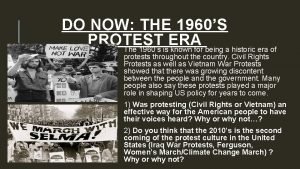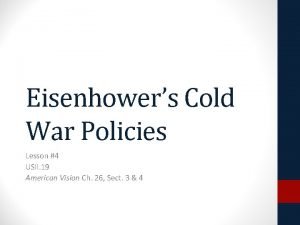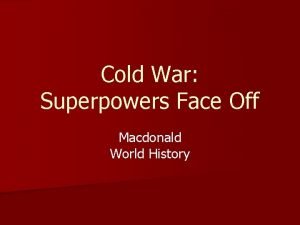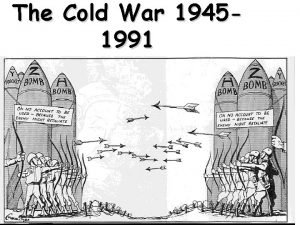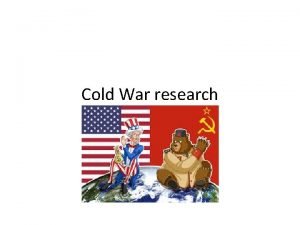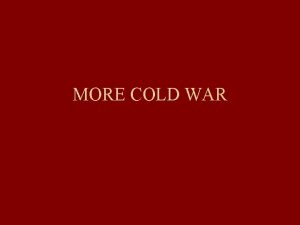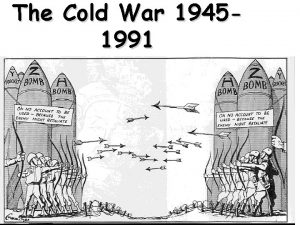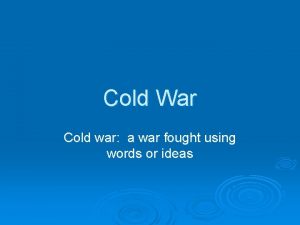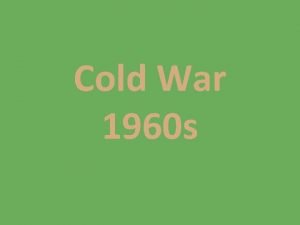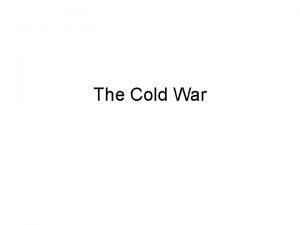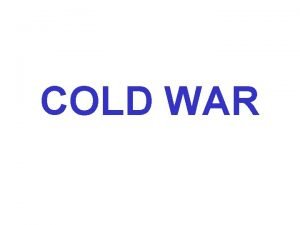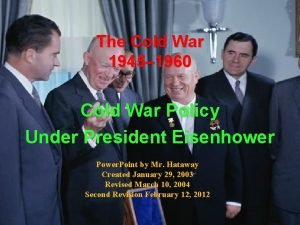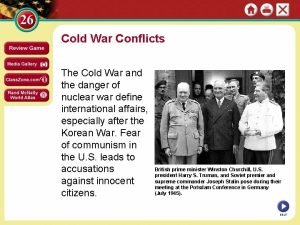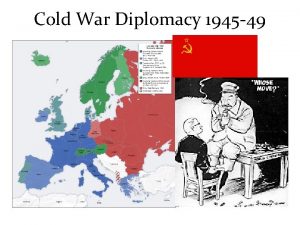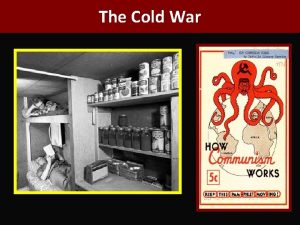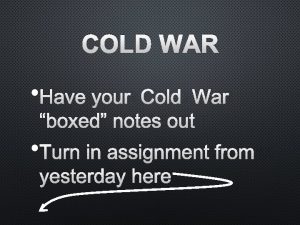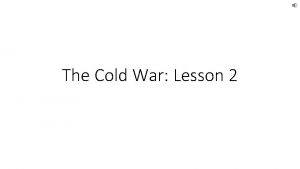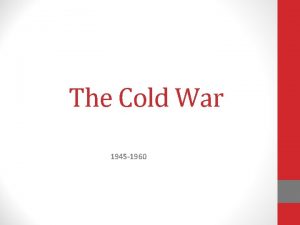The Cold War The Cold War Welcome to










































- Slides: 42

The Cold War

The Cold War • Welcome to this review lesson on the Cold War. • You have been placed in groups to work. • You will be given different cards during the lesson, which you will need to make a timeline. • Activity 1: Your first cards are the names of events. There are 26 events to place in the order in which they took place.

The Cold War • Activity 2: The next set of cards are 26 dates to match the events you have already placed in chronological order. • You can reorder the events and dates at any time with the agreement of your group.

The Cold War • Activity 3: Your next set of cards are definitions to match the events and dates you have already placed in chronological order. • You can reorder the dates, events and definitions at any time with the agreement of your group.

The Cold War • You should now review the timeline. You can reorder the dates, events and definitions with the agreement of your group. • Activity 4: You have a created a timeline of events that were preselected for you. Your group task is to use the blank cards to write down three more events, with dates and brief definitions, that your group think should be included on a timeline of the Cold War.

The Cold War • Timeline checker • The following slides are for you to check the timeline content.

YALTA CONFERENCE, 1945 The ‘Big Three’ met to sort out what would happen to Europe after the end of WWII. Problems arose immediately about the control of Eastern Europe. Stalin did eventually agree to the principle of ‘free elections’ in Eastern Europe. Agreements were also made that divided Germany and Berlin into four sectors owned jointly by the major powers, Britain, France, the USA and the USSR.

POTSDAM CONFERENCE, 1945 Roosevelt had died before this meeting and was replaced with Truman, and Churchill lost the election during this meeting and was replaced with Attlee. Stalin began to feel that he was not being shown the respect he deserved, especially by Truman, who attempted to intimidate Stalin with the news of the successful atomic bomb test in the USA.

FIRST USE OF ATOMIC BOMBS, 1945 ‘Little Boy’ bomb, dropped on Hiroshima on 6 August 1945, had a capacity of 12, 500 tons of TNT – it killed 70, 000 people within two seconds. ‘Fat Man’ bomb, dropped on Nagasaki on 9 August 1945, had a capacity of 25, 000 tons of TNT – it killed 50, 000 people within two seconds. Japan unconditionally surrendered on 14 August 1945.

COMMUNIST CONTROL OF EASTERN EUROPE GROWS 1945– 49 Albania (1945); Bulgaria (1945); Poland (1947); Hungary (1947); Romania (1945– 1947); Czechoslovakia (1945– 48); East Germany (1949) – Russia turned their zone of Germany into the German Democratic Republic in 1949.

KENNAN’S LONG TELEGRAM, 1946 An analysis of the foreign policy of the USSR and its possible future actions stated that the Soviet leadership were suspicious and aggressive and that there must be no compromises with the USSR. Only a hard-line approach would be effective in containing Communism. The analysis proved to be the basis for the Truman Doctrine.

TRUMAN DOCTRINE, 1947 The USA Pledged $400 million to help Greece and Turkey. Attempt to stave off Communism. First example of an active US policy to combat threat of Communism in Europe.

MARSHALL PLAN, 1948 The US pledged money to help countries that wished to stave off Communism. More than $13 billion was given to a vast number of European countries including Britain, France and West Germany. The USA made sure that all countries who took aid were now also major trading partners of the USA.

COMINFORM, 1948 An organisation that was set up to ‘co-ordinate’ Communist groups and parties across Europe.

COMECON, 1949 Scheme to provide economic assistance to the countries of Eastern Europe.

NATO, 1949 An organisation to provide a more centrally co-ordinated approach to the threat of Communist expansion. This established military cooperation in the event of war, and included countries such as Britain, France, Canada and Belgium, as well as many smaller Western European nations.

USSR GET THE A-BOMB, 1949 The USSR secretly tested their first Abomb a full six years earlier than the USA had expected them to. The radiation was detected, and thus the power balance of the Cold War had now dramatically been shifted.

Mc. CARTHYISM, 1950 A hunt for the ‘Reds under the Beds’ took off in the USA. Fear of Communist sympathisers inside America grew.

NSC-68, 1950 In the light of the new nuclear threat of Communism, a strategy was developed that outlined the new direction that the USA’s foreign policy needed to take in order to contain Communism. This new direction would now focus on ‘rollback’, the view that Communism needed to be confronted and pushed back to safeguard the free world.

WARSAW PACT, 1955 An agreement that coordinated the defences of the Soviet Bloc under the control of the Soviet Union. Members were even more reliant upon the USSR for military aid in the event of internal or external attacks.

KHRUSHCHEV’S ‘SECRET SPEECH’, 1956 A speech denouncing Stalinism and the cult of the individual. It pointed out in clear terms how dictatorial the regime of Stalin was, and exactly how he purged the Communist Party of any possible threats using illegal methods, including torture, in the late 1930 s. The speech seemed to many to herald a new era in the Communist Party.

U-2 SPY PLANE SHOT DOWN, 1960 A significant political victory for Khrushchev, who was able to highlight the underhand methods used by the USA to gain information, this event was particularly important as it was just before the two powers were due to meet at a peace conference in Paris. Khrushchev was furious at the blatant rudeness and betrayal that the USA had shown, remarking, ‘Why shit where you are about to eat? !’ Khrushchev stormed out of the conference.

BERLIN WALL, 1961 West Berlin had constantly been a thorn in the USSR’s side; they had lost millions of workers across the borders. Khrushchev intended to stop West Berlin from undermining the control and power of the USSR.

TSAR BOMB, 1961 The largest nuclear weapon ever detonated, in a test over the Arctic Ocean. The 57 megaton bomb was thousands of times more powerful than the atomic bomb dropped on Hiroshima.

CUBAN MISSILE CRISIS, 1962 The relationship between the USA and Cuba had deteriorated so much that they had looked to the USSR for help. In return for trade, the USSR was placing nuclear warheads and missiles on Cuba, only 60 miles away from mainland USA, meaning 90% of the USA was within range of the missiles that would take only five minutes to reach them.

GULF OF TONKIN RESOLUTION, 1964 Congress passed a unanimous vote, followed by a virtually unanimous vote of 88– 2, in the Senate, giving President Lyndon Johnson the authority to send American troops to Vietnam and to use ‘all necessary measures to repel armed attack’.

THE PRAGUE SPRING, 1968 A period of political liberalisation in Czechoslovakia. It began on 5 January, when reformist Slovak Alexander Dubček came to power, and continued until 21 August, when the Soviet Union and members of its Warsaw Pact allies invaded the country to halt the reform.

SALT I TREATY SIGNED (STRATEGIC ARMS LIMITATIONS TALKS), 1972 After two and a half years of negotiation, the first round of discussion was brought to a conclusion when President Nixon and General Secretary Brezhnev signed the ABM Treaty and the Interim Agreement.

INVASION OF AFGHANISTAN, 1979 This country was seen by Moscow as an important buffer state. Soviet troops were sent in to support the government against the Islamic Mujahedeen. America put a ban on the export of grain to Russia, ended the SALT talks taking place then and boycotted the Olympic Games due to be held in Moscow in 1980.

EASTERN EUROPE CHANGES DIRECTION, 1989 Poland, Hungary, Czechoslavakia, Romania, Bulgaria and Albania all rejected communism as a political system.

MALTA SUMMIT, 1989 Gorbachev and Bush established a good working relationship. No new agreements were made, but both leaders declared that the Cold War was over.

COMMUNISM IN EUROPE FALLS, 1991 With the Eastern Bloc becoming more independent, the Soviet empire itself began to crumble. On 8 December, the Soviet Union ceased to exist.

The Cold War • Activity 5: The next two sets of cards have the leaders of the USA and USSR during the Cold War period. Place them on the timeline in the correct sequence.

WARNING! Leaders slides follow

Presidents of the USA Harry Truman 1945– 1953 Dwight D Eisenhower 1953– 1961 John F Kennedy 1961– 1963 Lyndon B Johnson 1963– 1969 Richard Nixon 1969– 1974 Gerald Ford 1974– 1977 Jimmy Carter 1977– 1981 Ronald Reagan 1981– 1989 George Bush 1989– 1993

Leaders of the USSR Joseph Stalin 1928– 1953 Georgy Malenkov 1953– 1955 Nikita Khrushchev 1955– 1964 Leonid Brezhnev 1964– 1982 Yuri Andropov 1982– 1984 Konstantin Chernenko 1984– 1985 Mikhail Gorbachev 1985– 1991

The Cold War Activity 6 • Each group should discuss the events together and select one that they consider to be the most significant event of the Cold War. • A spokesperson from each group will explain why they have chosen their event.

The Cold War: Historical interpretations Activity 7 • The interpretation cards are the titles of different schools of historical interpretation. • There are four cards and they should be placed roughly within the time period they cover. • Now add the description cards that describe the main ideas of each of the four groups of historians. Match them to the school of thought already added. • Your final set of cards has historians’ names, and these need to be placed with the matching description cards.

Historical Interpretations • Traditional/Orthodox – 1950 s–early 1960 s • Key historians – George Kennan, Herbert Feis, Thomas A Bailey • Revisionist – 1960 s–mid-1980 s • Key historians – William A Williams, Walter La. Feber, Gar Alperovitz, Joyce and Gabriel Kolko • Post-revisionist – 1980 s • Key historians – John Lewis Gaddis, Thomas G Paterson, Ernest May • Contemporary/Post-1991 – 1990 s onward • Key historians – Eduard Mark, Tony Smith

The Cold War Activity 8: Using the Historiography sheet provided, write down three events in each box that could support the historical interpretation in a debate. Use the timeline to help – this is not a memory test.

The Cold War • Activity 9: On the Cold War interpretations chart, you are going to analyse an interpretation of the cause of the Cold War. • There are prompts on the sheet to help you. • You can use the timeline and the historiography sheet too. • You can also add any other information you feel is relevant. • The sheet will become a plan for you to answer the question at the top of the interpretations chart.

The Cold War • Using the Cold War interpretations chart, write an answer to the question set in the title. • You have ……. . minutes to complete the question. • Remember to consider SPa. G.
 Lesson 1 the origins of the cold war
Lesson 1 the origins of the cold war Proxy wars during the cold war
Proxy wars during the cold war Welcome welcome this is our christmas story
Welcome welcome this is our christmas story Why did the arms race escalate during the cold war
Why did the arms race escalate during the cold war Communist and capitalist countries cold war
Communist and capitalist countries cold war Cold war knowledge organiser
Cold war knowledge organiser Chapter 26 section 1 origins of the cold war
Chapter 26 section 1 origins of the cold war Starkweather homicide 1958
Starkweather homicide 1958 Cold war mikhail gorbachev
Cold war mikhail gorbachev Cold war tension graph
Cold war tension graph Cold war jeopardy
Cold war jeopardy Operation rolling thunder cold war
Operation rolling thunder cold war Chapter 25 cold war america
Chapter 25 cold war america Hysteria in the crucible
Hysteria in the crucible Two sides of the cold war
Two sides of the cold war Cold war jeopardy review game
Cold war jeopardy review game Cold war acrostic
Cold war acrostic The cold war vocab
The cold war vocab The cold war begins 1945-1960
The cold war begins 1945-1960 What does salt stand for cold war
What does salt stand for cold war Bernard baruch cold war
Bernard baruch cold war Superpowers cold war
Superpowers cold war Was the cold war capitalism vs communism
Was the cold war capitalism vs communism Chapter 17 section 1 cold war: superpowers face off answers
Chapter 17 section 1 cold war: superpowers face off answers 1947 1991
1947 1991 Weapons of the cold war diagram
Weapons of the cold war diagram Origins of the cold war
Origins of the cold war Napalm vietnam war
Napalm vietnam war Brinkmanship cold war
Brinkmanship cold war Communism cold war
Communism cold war Cold war
Cold war The cold war at its height
The cold war at its height Cold war vocabulary
Cold war vocabulary Chapter 26 section 2 guided reading the cold war heats up
Chapter 26 section 2 guided reading the cold war heats up The cold war heats up chapter 18 section 2
The cold war heats up chapter 18 section 2 The cold war intensifies
The cold war intensifies Lord of the flies anticipation guide
Lord of the flies anticipation guide Iron curtain map activity
Iron curtain map activity All communist countries during the cold war
All communist countries during the cold war Causes for the cold war
Causes for the cold war Doves cold war
Doves cold war Lesson 4 eisenhowers cold war policies
Lesson 4 eisenhowers cold war policies History of cold war
History of cold war



